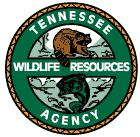| Tennessee Wildlife Resources Agency | |
|---|---|
 | |
| Abbreviation | TWRA |
| Agency overview | |
| Formed | 1974 |
| Preceding agency |
|
| Employees | 600+ |
| Annual budget | 85.6 million USD |
| Jurisdictional structure | |
| Operations jurisdiction | Tennessee, United States |
| Legal jurisdiction | State of Tennessee |
| Governing body | Tennessee Wildlife Resources Commission |
| Operational structure | |
| Headquarters | Ellington Agricultural Center, Nashville, Tennessee |
| Agency executives |
|
| Regions | I (Jackson), II (Nashville), III (Crossville) and IV (Morristown) |
| Facilities | |
| Patrol cars | GMC, Ford and Dodge Light trucks and SUVs |
| Boats | Various patrol and utility craft |
| Observations | Partenavia P.68 Observer 2 [1] |
| Website | |
| http://www.tennessee.gov/twra | |
The Tennessee Wildlife Resources Agency (TWRA) is an independent state agency of the state of Tennessee with the mission of managing the state's fish and wildlife and their habitats, as well as responsibility for all wildlife-related law enforcement activities. The agency also has responsibility for fostering the safe use of the state's waters through a program of law enforcement, education, and access.
Contents
- History
- Organization
- Tennessee Fish and Wildlife Commission
- Regions
- Officer rank structure
- Law enforcement
- Forensics
- Homeland security and disaster response
- Support programs
- Conservation
- Wildlife reintroduction
- Wildlife management areas
- Education and public outreach
- Tennessee Hunter Education Program
- Tennessee Scholastic Clay Target Program
- Tennessee Wildlife magazine
- See also
- References
- External links
The TWRA is engaged in hunter education and training through the Tennessee Hunter Education Program, provides support to the "Archery in the Schools Program," and gives financial support to safety and competitive shooting programs through the Tennessee Wildlife Federation's Tennessee Scholastic Clay Target Program.